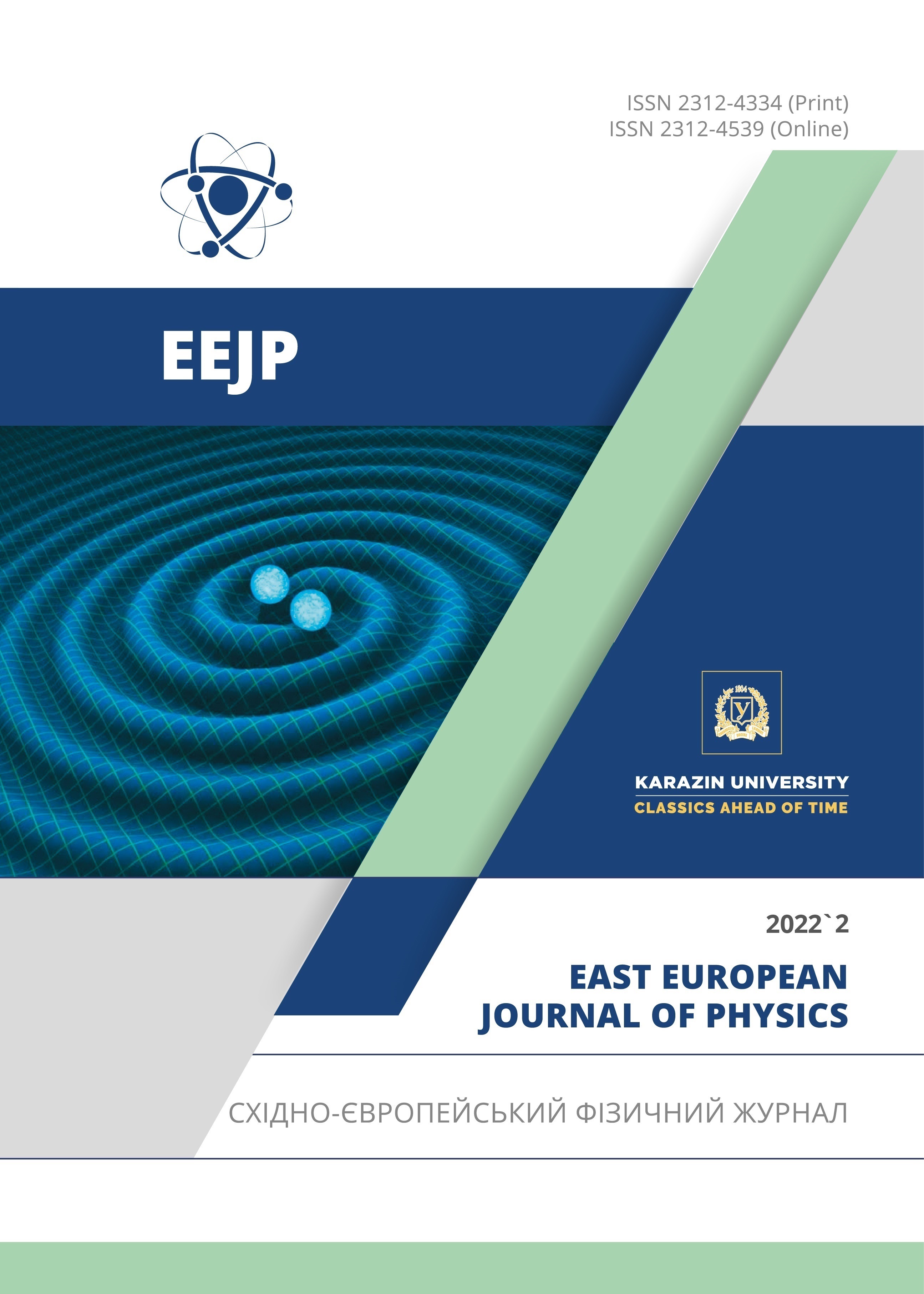Дослідження електричних властивостей покриттів nano TiO2 на основі характеристичної матричної теорії і моделі Брюса
Анотація
Досліджено електричні властивості нанопокриттів TiO2 у залежності від розміру наночастинок. Крім того, у дослідженні вивчається, як розрахувати енергію квантового утримання TiO2. Результати підтверджують вплив розміру частинок на електричні властивості, особливо коли розмір стає близьким до радіусу екситона Бора. Електричні властивості не змінюються, коли розмір стає близьким до 40 нм. Встановлено, що радіус Бора покриттів Nano TiO2 становить 1,4 нм, тоді як енергія утримання становила 0,43 еВ. Програма залежить від характеристичної матричної теорії та моделі Брюса.
Завантаження
Посилання
U. Woggon, Optical Properties of Semiconductor Quantum Dots, (Springer-Verlag Berlin Heidelberg, Germany, 1997).
N.N. Greenwood, and A. Earnshaw, Chemistry of the elements, (Butterworth-Heinemann, Oxford, 1997).
A.A. Al-Khafaji, Ph.D. Thesis. Photocatalysis of Sol-Gel Derived TiO2 for Anti-Dust Properties, University of Baghdad, 2013.
P. Baumeister, Optical Coating Technology, (SPIE Press, 2004).
A. Wisitsoraat, A. Tuantranont, E. Comini, G. Sberveglieri, and W. Wlodarski, “Characterization of n-type and p-type semiconductor gas sensors based on NiOx doped TiO2 thin films, Thin Solid Films”, 517(8), 2775 (2009). https://doi.org/10.1016/j.tsf.2008.10.090
F. Schmidt-Stein, R. Hahn, J.F. Gnichwitz, Y.Y. Song, N.K. Shrestha, A. Hirsch, and P. Schmuki, “X-ray induced photocatalysis on TiO2 and TiO2 nanotubes: Degradation of organics and drug release”, Electrochem. Commun. 11, 2077 (2009), http://dx.doi.org/10.1016/j.elecom.2009.08.036
K. Karki, K.I. Gnanasekar, and B. Rambabu "Nanostructure Semiconductor Oxide Powders and Thin Films for Gas Sensors" Appl. Sur. Sci. 399, 193 (2006), https://www.electrochem.org/dl/ma/202/pdfs/0025.pdf
C. Burda, X. Chen, R. Narayanan, and M.A. El-Sayed, “Chemistry and properties of nanocrystals of different shapes”, Chemical reviews, 105(4), 1025 (2005), https://doi.org/10.1021/cr030063a
L.E. Brus, “Electron-Electron and Electron-Hole Interactions in Small Semiconductor Crystallites: The Size Dependence of the Lowest Excited Electronic State”, Journal of Chemical Physics, 80(9), 4403 (1984), https://doi.org/10.1063/1.447218
Z.L. Wang, Y. Liu, and Z. Zhang, editors, Handbook of nanophase and nanostructured materials, Volume II (Kluwer Academic/Plenum Publishers, Tsinghua University Press, 2003), pp. 428.
B. Bhattacharjee, D. Ganguli, K. Iakoubovskii, A. Stesmans, and S. Chaudhuri, “Synthesis and characterization of sol-gel derived ZnS: Mn2+ nanocrystallites embedded in a silica matrix”, Indian Academy of Sciences, 25(3), 175 (2002). https://doi.org/10.1007/BF02711150
H.A. Macleod, Thin-Film Optical Filters, Fourth Edition, ISBN: 9781420073027, (CRC Press, Taylor & Francis Group, LLC, 2010), pp. 772.
N.M. Ahmed, Design and experimental studies of Multilayer Coatings for Applications in Gallium nitride Emitting Devices, Ph.D. Thesis, University Sa ins Malaysia, 2006(
S.M. Abed, and S.N.T. Al-Rashid, “Designing High reflectivity Omnidirectional coating of Mirrors for Near Infrared Spectrum (700-2500nm)”, Applied physics Research, 5(1), 102 (2013), https://doi.org/10.5539/apr.v5n1p102
A. Scaff, “Introduction to Nanotechnology (Science, Engineering & Applications)” Series of Strategic and Advanced Techniques, Arabic Compendium of Translation, INSB: 139789953824437, (2011).
G. Cao, and Y. Wang, Nanostructures and Nanomaterials: Synthesis, Properties, and Applications, ISBN: 9781783260881, (Imperial College Press, 2004), https://doi.org/10.1142/7885
T. Edvinsson, “Optical quantum confinement and photocatalytic properties in two-, one- and zero- dimensional nanostructures”, Royal Society Open Science, 5(9), 180387 (2018), https://doi.org/10.1098/rsos.180387
Z.L. Wang, Y. Liu, and Z. Zhang, editors, Handbook of nanophase and nanostructured materials, Volume II, ISBN: 9780306472497 (Kluwer Academic Plenum, 2003), pp. 406.
P. Parameshwari, B. Shashidhara, and K. Gopalakrishna, “Structural Electrical and Optical Studies on Spray Deposited Cadmium Sulphide and Copper Indium Disulphide thin films”, Arch. of Physics Research, 3, 441 (2012). https://www.researchgate.net/publication/281333311_Structural_electrical_and_optical_studies_on_spray_deposited_cadmium_sulphide_and_copper_indium_disulphide_thin_film
R. Zallen, The physics of amorphous solids, (Wiley, New York, 1983), pp. 297.
S.X. Xue, S.H. Liu, W. Zhang, J. Wang, L. Tang, B. Shen, and J.W. Zhai, “Dielectric properties and charge-discharge behaviors in niobate glass ceramics for energy-storage applications,” J. Alloys Compd. 617, 418 (2014) https://doi.org/10.1016/j.jallcom.2016.06.024
G.R. Patel, and T.C. Pandya, “Effect of size and shape on static Refractive Index, Dielectric constant and Band gap of Nano solids”, Physics and Applied Sciences, 6(1), 37-42 (2018), https://doi.org/10.26438/ijsrpas/v6i1.3742
Авторське право (c) 2022 Сара А. Хіджаб, Саїд Н.Т. аль-Рашид

Цю роботу ліцензовано за Міжнародня ліцензія Creative Commons Attribution 4.0.
Автори, які публікуються у цьому журналі, погоджуються з наступними умовами:
- Автори залишають за собою право на авторство своєї роботи та передають журналу право першої публікації цієї роботи на умовах ліцензії Creative Commons Attribution License, котра дозволяє іншим особам вільно розповсюджувати опубліковану роботу з обов'язковим посиланням на авторів оригінальної роботи та першу публікацію роботи у цьому журналі.
- Автори мають право укладати самостійні додаткові угоди щодо неексклюзивного розповсюдження роботи у тому вигляді, в якому вона була опублікована цим журналом (наприклад, розміщувати роботу в електронному сховищі установи або публікувати у складі монографії), за умови збереження посилання на першу публікацію роботи у цьому журналі.
- Політика журналу дозволяє і заохочує розміщення авторами в мережі Інтернет (наприклад, у сховищах установ або на особистих веб-сайтах) рукопису роботи, як до подання цього рукопису до редакції, так і під час його редакційного опрацювання, оскільки це сприяє виникненню продуктивної наукової дискусії та позитивно позначається на оперативності та динаміці цитування опублікованої роботи (див. The Effect of Open Access).








